Abstract
The binding of plasmid DNA to norfloxacin, a quinolone antibacterial agent, was investigated by fluorescence, electrophoretic DNA unwinding, and affinity chromatography techniques. The amount of quinolone bound to DNA was modulated by the concentration of Mg2+. No interaction was evident in the absence of Mg2+ or in the presence of an excess of Mg2+, whereas maximum binding was observed at a Mg2+ concentration of 1-2 mM. The experimental data can be fitted to the formation of three types of Mg adducts: a binary adduct with norfloxacin and Mg2+, a binary adduct with DNA and Mg2+, and a ternary adduct with quinolone, plasmid, and Mg2+. We propose a model for the ternary complex, in which Mg acts as a bridge between the phosphate groups of the nucleic acid and the carbonyl and carboxyl moieties of norfloxacin. Additional stabilization may arise from stacking interactions between the condensed rings of the drug and DNA bases (especially guanine and adenine), which may account for the preference exhibited by quinolones for single-stranded and purine-rich regions of nucleic acids. Other possible biochemical pathways of drug action are suggested by the observation that norfloxacin binds Mg2+ under conditions that are close to physiological.
Full text
PDF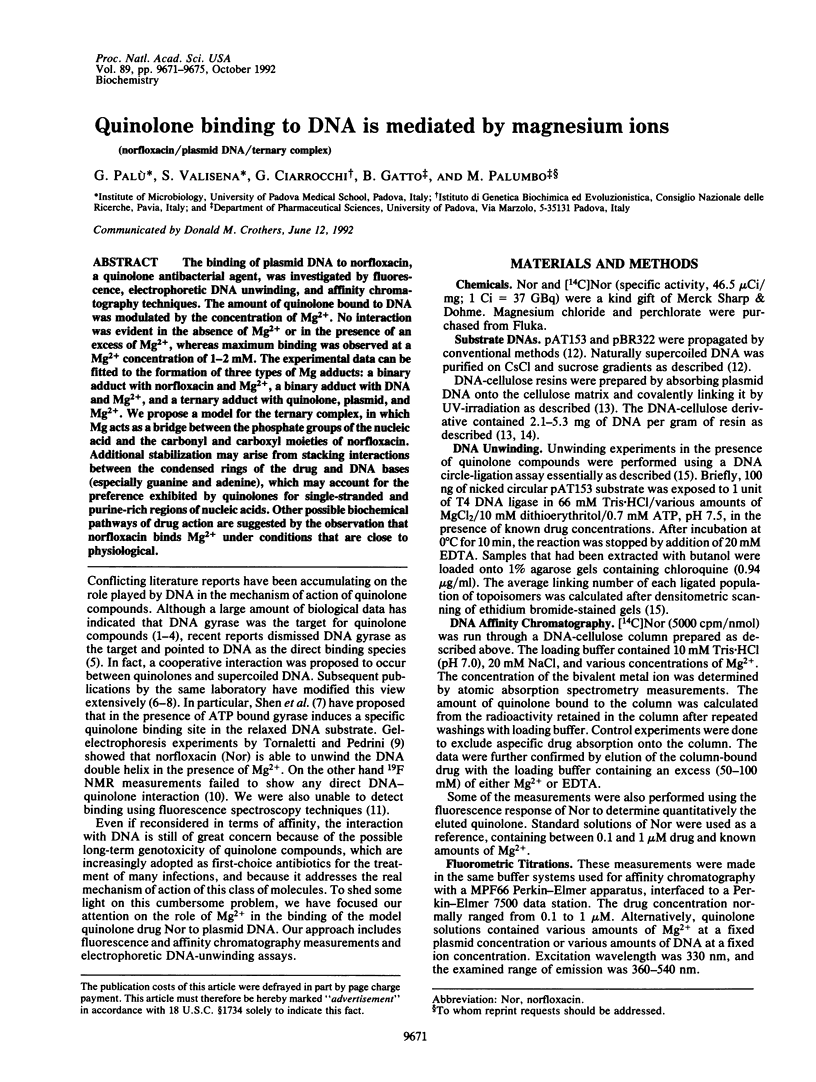
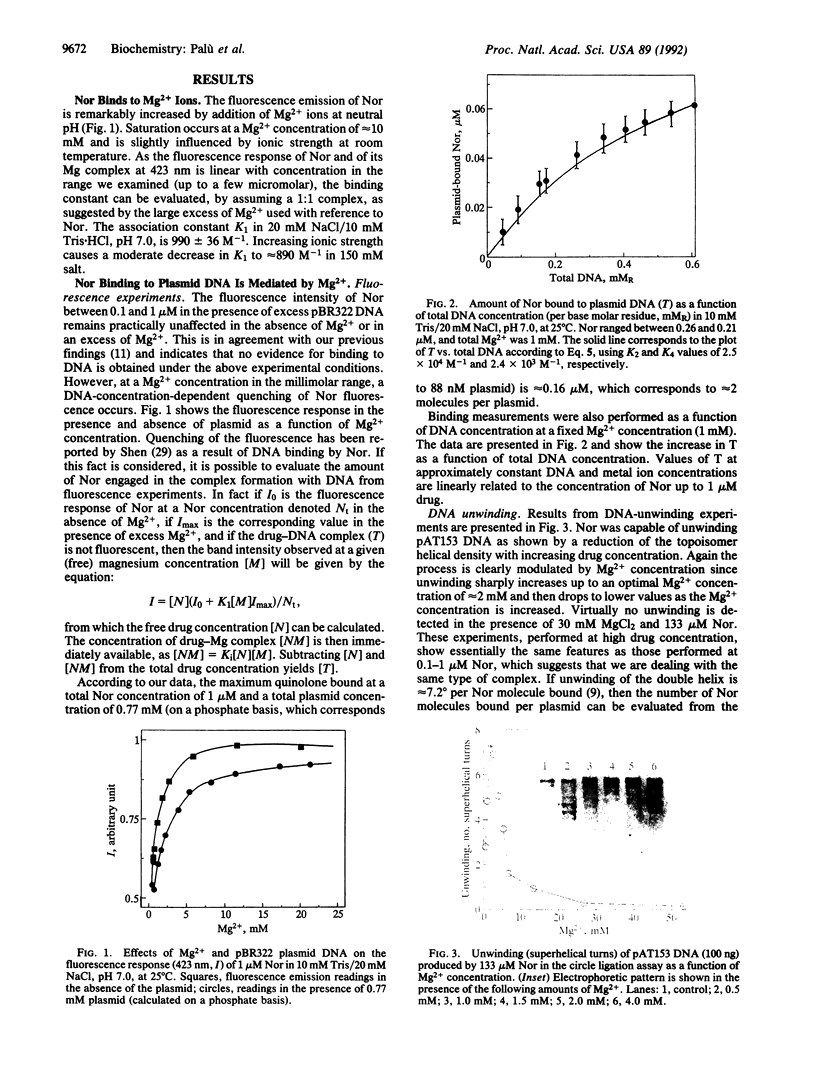
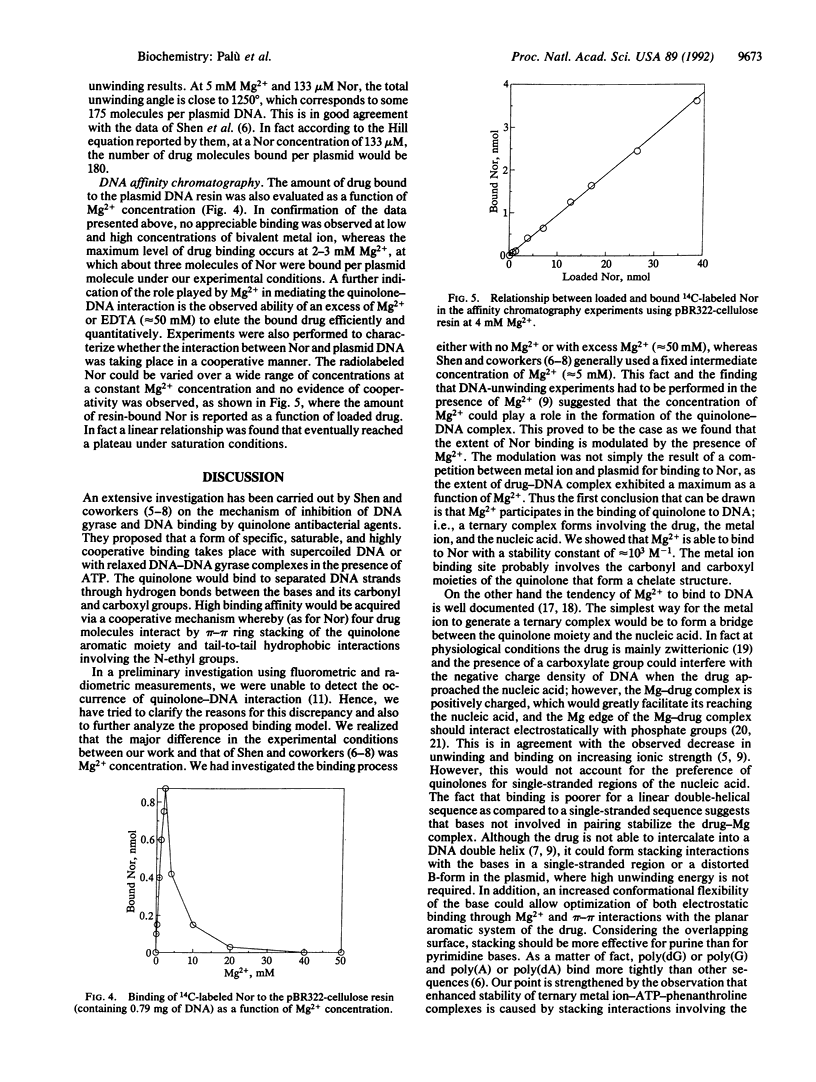
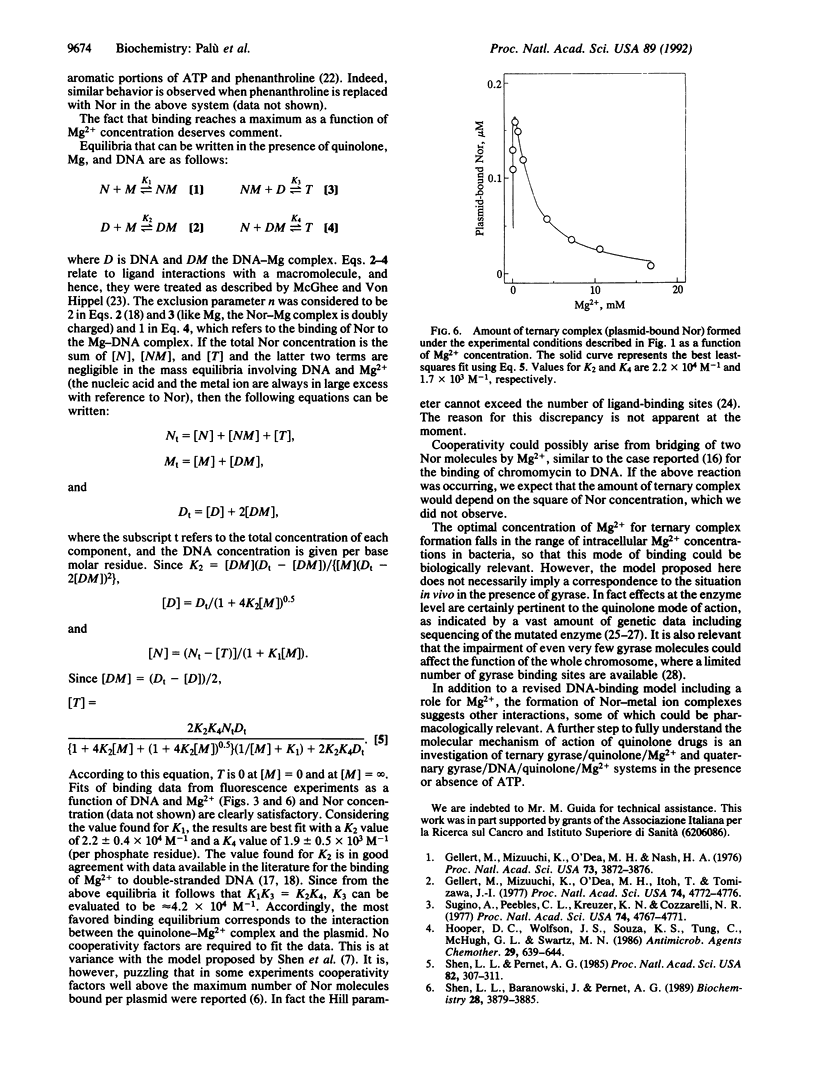
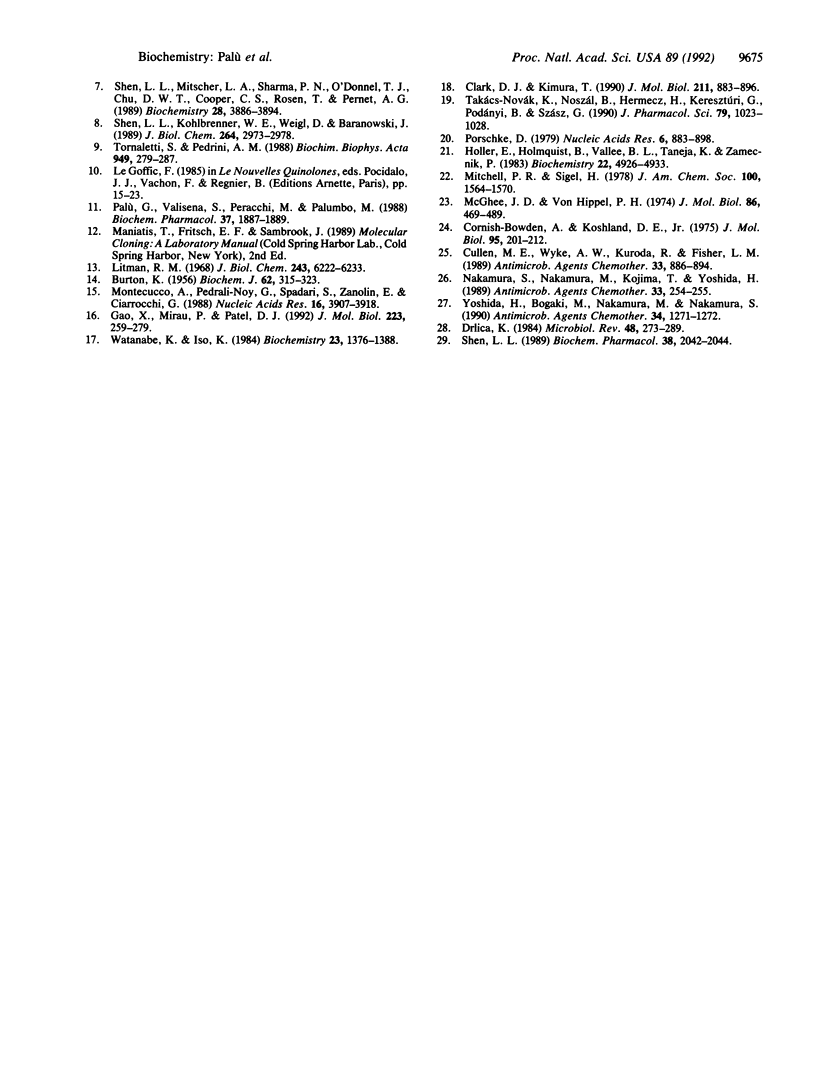
Images in this article
Selected References
These references are in PubMed. This may not be the complete list of references from this article.
- BURTON K. A study of the conditions and mechanism of the diphenylamine reaction for the colorimetric estimation of deoxyribonucleic acid. Biochem J. 1956 Feb;62(2):315–323. doi: 10.1042/bj0620315. [DOI] [PMC free article] [PubMed] [Google Scholar]
- Clark D. J., Kimura T. Electrostatic mechanism of chromatin folding. J Mol Biol. 1990 Feb 20;211(4):883–896. doi: 10.1016/0022-2836(90)90081-V. [DOI] [PubMed] [Google Scholar]
- Cornish-Bowden A., Koshland D. E., Jr Diagnostic uses of the Hill (Logit and Nernst) plots. J Mol Biol. 1975 Jun 25;95(2):201–212. doi: 10.1016/0022-2836(75)90390-3. [DOI] [PubMed] [Google Scholar]
- Cullen M. E., Wyke A. W., Kuroda R., Fisher L. M. Cloning and characterization of a DNA gyrase A gene from Escherichia coli that confers clinical resistance to 4-quinolones. Antimicrob Agents Chemother. 1989 Jun;33(6):886–894. doi: 10.1128/aac.33.6.886. [DOI] [PMC free article] [PubMed] [Google Scholar]
- Drlica K. Biology of bacterial deoxyribonucleic acid topoisomerases. Microbiol Rev. 1984 Dec;48(4):273–289. doi: 10.1128/mr.48.4.273-289.1984. [DOI] [PMC free article] [PubMed] [Google Scholar]
- Gao X. L., Mirau P., Patel D. J. Structure refinement of the chromomycin dimer-DNA oligomer complex in solution. J Mol Biol. 1992 Jan 5;223(1):259–279. doi: 10.1016/0022-2836(92)90730-8. [DOI] [PubMed] [Google Scholar]
- Gellert M., Mizuuchi K., O'Dea M. H., Itoh T., Tomizawa J. I. Nalidixic acid resistance: a second genetic character involved in DNA gyrase activity. Proc Natl Acad Sci U S A. 1977 Nov;74(11):4772–4776. doi: 10.1073/pnas.74.11.4772. [DOI] [PMC free article] [PubMed] [Google Scholar]
- Gellert M., Mizuuchi K., O'Dea M. H., Nash H. A. DNA gyrase: an enzyme that introduces superhelical turns into DNA. Proc Natl Acad Sci U S A. 1976 Nov;73(11):3872–3876. doi: 10.1073/pnas.73.11.3872. [DOI] [PMC free article] [PubMed] [Google Scholar]
- Holler E., Holmquist B., Vallee B. L., Taneja K., Zamecnik P. Circular dichroism and ordered structure of bisnucleoside oligophosphates and their Zn2+ and Mg2+ complexes. Biochemistry. 1983 Oct 11;22(21):4924–4933. doi: 10.1021/bi00290a008. [DOI] [PubMed] [Google Scholar]
- Hooper D. C., Wolfson J. S., Souza K. S., Tung C., McHugh G. L., Swartz M. N. Genetic and biochemical characterization of norfloxacin resistance in Escherichia coli. Antimicrob Agents Chemother. 1986 Apr;29(4):639–644. doi: 10.1128/aac.29.4.639. [DOI] [PMC free article] [PubMed] [Google Scholar]
- Litman R. M. A deoxyribonucleic acid polymerase from Micrococcus luteus (Micrococcus lysodeikticus) isolated on deoxyribonucleic acid-cellulose. J Biol Chem. 1968 Dec 10;243(23):6222–6233. [PubMed] [Google Scholar]
- McGhee J. D., von Hippel P. H. Theoretical aspects of DNA-protein interactions: co-operative and non-co-operative binding of large ligands to a one-dimensional homogeneous lattice. J Mol Biol. 1974 Jun 25;86(2):469–489. doi: 10.1016/0022-2836(74)90031-x. [DOI] [PubMed] [Google Scholar]
- Montecucco A., Pedrali-Noy G., Spadari S., Zanolin E., Ciarrocchi G. DNA unwinding and inhibition of T4 DNA ligase by anthracyclines. Nucleic Acids Res. 1988 May 11;16(9):3907–3918. doi: 10.1093/nar/16.9.3907. [DOI] [PMC free article] [PubMed] [Google Scholar]
- Nakamura S., Nakamura M., Kojima T., Yoshida H. gyrA and gyrB mutations in quinolone-resistant strains of Escherichia coli. Antimicrob Agents Chemother. 1989 Feb;33(2):254–255. doi: 10.1128/aac.33.2.254. [DOI] [PMC free article] [PubMed] [Google Scholar]
- Palù G., Valisena S., Peracchi M., Palumbo M. Do quinolones bind to DNA? Biochem Pharmacol. 1988 May 1;37(9):1887–1888. doi: 10.1016/0006-2952(88)90496-0. [DOI] [PubMed] [Google Scholar]
- Pörschke D. The mode of Mg++ binding to oligonucleotides. Inner sphere complexes as markers for recognition? Nucleic Acids Res. 1979 Mar;6(3):883–898. doi: 10.1093/nar/6.3.883. [DOI] [PMC free article] [PubMed] [Google Scholar]
- Shen L. L. A reply: "Do quinolones bind to DNA?"--Yes. Biochem Pharmacol. 1989 Jun 15;38(12):2042–2044. doi: 10.1016/0006-2952(89)90505-4. [DOI] [PubMed] [Google Scholar]
- Shen L. L., Baranowski J., Pernet A. G. Mechanism of inhibition of DNA gyrase by quinolone antibacterials: specificity and cooperativity of drug binding to DNA. Biochemistry. 1989 May 2;28(9):3879–3885. doi: 10.1021/bi00435a038. [DOI] [PubMed] [Google Scholar]
- Shen L. L., Kohlbrenner W. E., Weigl D., Baranowski J. Mechanism of quinolone inhibition of DNA gyrase. Appearance of unique norfloxacin binding sites in enzyme-DNA complexes. J Biol Chem. 1989 Feb 15;264(5):2973–2978. [PubMed] [Google Scholar]
- Shen L. L., Mitscher L. A., Sharma P. N., O'Donnell T. J., Chu D. W., Cooper C. S., Rosen T., Pernet A. G. Mechanism of inhibition of DNA gyrase by quinolone antibacterials: a cooperative drug--DNA binding model. Biochemistry. 1989 May 2;28(9):3886–3894. doi: 10.1021/bi00435a039. [DOI] [PubMed] [Google Scholar]
- Shen L. L., Pernet A. G. Mechanism of inhibition of DNA gyrase by analogues of nalidixic acid: the target of the drugs is DNA. Proc Natl Acad Sci U S A. 1985 Jan;82(2):307–311. doi: 10.1073/pnas.82.2.307. [DOI] [PMC free article] [PubMed] [Google Scholar]
- Sugino A., Peebles C. L., Kreuzer K. N., Cozzarelli N. R. Mechanism of action of nalidixic acid: purification of Escherichia coli nalA gene product and its relationship to DNA gyrase and a novel nicking-closing enzyme. Proc Natl Acad Sci U S A. 1977 Nov;74(11):4767–4771. doi: 10.1073/pnas.74.11.4767. [DOI] [PMC free article] [PubMed] [Google Scholar]
- Takács-Novák K., Noszál B., Hermecz I., Keresztúri G., Podányi B., Szász G. Protonation equilibria of quinolone antibacterials. J Pharm Sci. 1990 Nov;79(11):1023–1028. doi: 10.1002/jps.2600791116. [DOI] [PubMed] [Google Scholar]
- Tornaletti S., Pedrini A. M. Studies on the interaction of 4-quinolones with DNA by DNA unwinding experiments. Biochim Biophys Acta. 1988 Mar 31;949(3):279–287. doi: 10.1016/0167-4781(88)90153-4. [DOI] [PubMed] [Google Scholar]
- Watanabe K., Iso K. Magnesium binding and conformational change of DNA in chromatin. Biochemistry. 1984 Mar 27;23(7):1376–1383. doi: 10.1021/bi00302a007. [DOI] [PubMed] [Google Scholar]
- Yoshida H., Bogaki M., Nakamura M., Nakamura S. Quinolone resistance-determining region in the DNA gyrase gyrA gene of Escherichia coli. Antimicrob Agents Chemother. 1990 Jun;34(6):1271–1272. doi: 10.1128/aac.34.6.1271. [DOI] [PMC free article] [PubMed] [Google Scholar]



